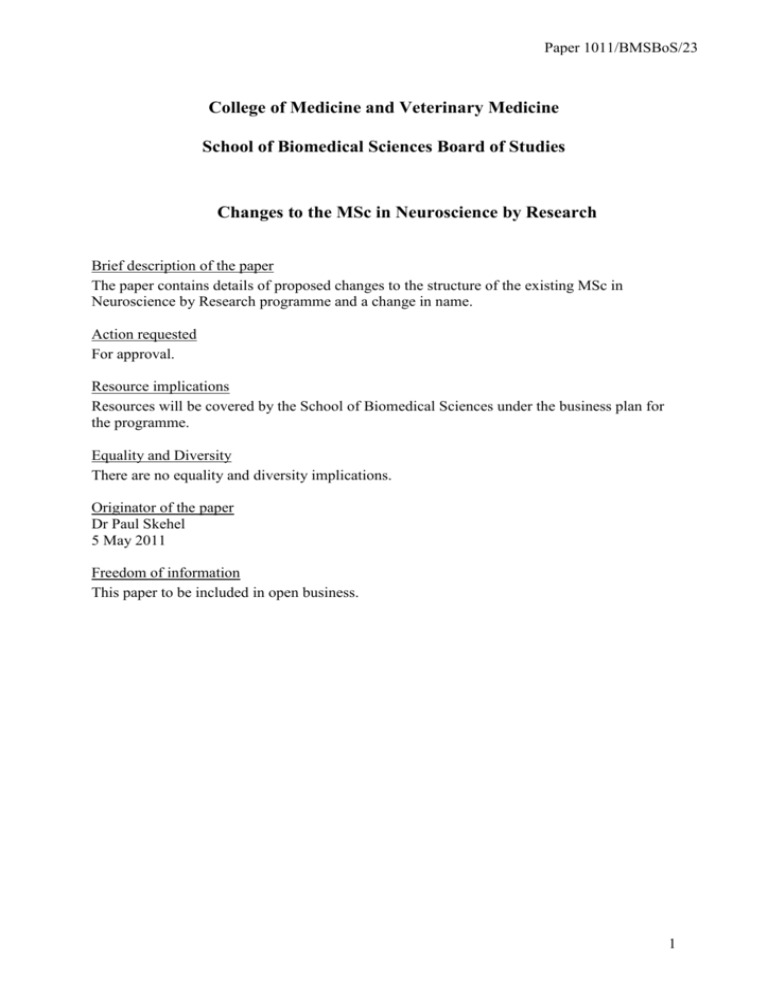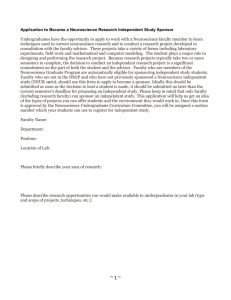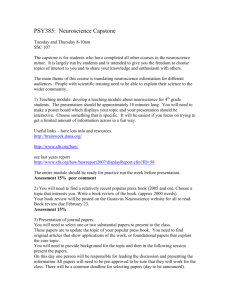Changes to the MSc in Neuroscience by Research
advertisement

Paper 1011/BMSBoS/23 College of Medicine and Veterinary Medicine School of Biomedical Sciences Board of Studies Changes to the MSc in Neuroscience by Research Brief description of the paper The paper contains details of proposed changes to the structure of the existing MSc in Neuroscience by Research programme and a change in name. Action requested For approval. Resource implications Resources will be covered by the School of Biomedical Sciences under the business plan for the programme. Equality and Diversity There are no equality and diversity implications. Originator of the paper Dr Paul Skehel 5 May 2011 Freedom of information This paper to be included in open business. 1 Proposal for MSc Neuroscience Programmes. Aim: To further develop the existing MSc in Neuroscience by Research course and thereby attract greater numbers of postgraduate students to the College. The current MSc in Neuroscience by Research as been running for nearly 15 years, and has had an annual average of 9-10 students over the last 5 years. The current aim is to exploit the research interests of staff in order to increase the number of postgraduate students undertaking neuroscience-related studies within the School. In one approach each research centre with interests in Neuroscience could potentially establish its own specialized MSc course. However, in order to be attractive and relevant to a realistic range of potential students, each of these courses would need to include a large component of more general neuroscience. This would necessarily entail an inefficient duplication of teaching and administrative resource, and could also compromise the existing successful Neuroscience MSc. We would like to present this draft proposal for a Neuroscience MSc course out-line that would enhance the current MSc and broaden its appeal to students with more specialized research interests and thus increase student numbers. The proposed structure would fully maintain or strengthen the existing links between other postgraduate course in Neuroinformatics Doctoral Training Centre (DTC), Biomedical Science (MSc) and Cognitive Ageing and Cognitive Epidemiology (MSc), and be compatible with the BBSRC Masters Training Grant (MTA) for Integrated Neurophysiology. General structure. It is suggested that the existing course be re-badged as an MSc in “Integrative Neuroscience by Research”. As is currently the case, formal taught components would be delivered in Semester 1. The existing course content would remain, comprising a “core” of General Neuroscience that would represent 80% of student effort. In parallel, new more specialised content would be provided by Elective components comprising the remaining 20% of Semester 1. After Semester 1 the programme would be committed to full-time practical laboratory work. 2 Semester 1. All taught components would be restricted to Semester 1. This is the situation for the existing course and has several advantages: Project supervisors can expect a clear full-time commitment from students Maintains the current successful participation of the Neuroinformatics DTC Will improve integration with existing MSc courses in Biomedical Science and Cell Communication. Two time slots would be left free each week, during which the specialized training relevant to new Elective components would be delivered. Currently three electives are anticipated: Regenerative Neuroscience (Brophy/Minichiello), Developmental Neurobiology (Price/Kind) and Neural Circuits: from ion channels to computation (Nolan). With this model additional components from other Centres could be added at any time in the future. Thus, in Semester 1 student would spend 80% of their time on the “core” General Neuroscience material, and the remaining 20% on material provide by the more specialised electives. Core Structure. Each week during Semester 1 would be dedicated to a different general research theme. The detail of these thematic weeks would be determined by the relevant organisers, however the aim would be to include 1 or 2 introductory lectures, 2 research seminars or practical workshops delivered by PIs or senior post-doctoral fellows, and a journal review. The following weekly themes are part of the existing Neuroscience course and would form the Core Structure. General Anatomy and Development of the Nervous System. (Gillingwater, Price and Kind) Membranes and Membrane Proteins – structures and functions. (Chamberlain, Wyllie) Neuroendocrinology and Behaviour. (Ludwig) Learning and Memory – circuits and mechanisms. (Nolan and Wood) Degeneration/Regeneration. (Brophy and Minichiello) Language and cognition. (Bak) Neuroinformatics. (Mark van Rossum/Jim Bednar) Diseases of the Brain. (McCulloch) 3 Additional core content delivered throughout Semester 1: Brain Imaging will be delivered on-line on Tuesday afternoons as arranged by the unit at the Western General Hospital. Modules on the Technical and Theoretical basis of imaging include Imaging Basics, Computed Tomography, Magnetic Resonance (MR) Spectroscopy, MR Diffusion, Permeability and Perfusion Imaging, and Experimental Imaging. Modules on Clinical applications will include Neurosurgery, Motor Neuron Disease, Schizophrenia, Depression, and White Matter changes in aging. Tuesday mornings are committed to the MSc course in Cognitive Ageing and Epidemiology. Transkills courses will be taken in Project Planning, Scientific Writing and Effective Presentations. In addition, the first 3 modules of the Personal Licence relating to the Animals Act will be taken. Where possible these will be concentrated over the week of Society for Neuroscience Annual meeting, which will be otherwise left free. New Elective components. Monday afternoons and Friday mornings would be left free for elective-specific study. This would provide additional training relating to a specific research area and could take the form of specialized journal clubs, workshops, technical training, or additional lectures and seminars delivered in greater depth and detail than the material delivered in the core General Neuroscience. Each student will either choose or be allocated to one of the elective components. The content material would be the responsibility of each organiser of the new electives. These new elective components could also be offered as Semester 1 module options for the Biomedical Science MSc course organized by Prof. Margarete Heck. Three new elective options are anticipated: Regenerative Neuroscience (Brophy/Minichiello), Developmental Neurobiology (Price/Kind), Neural Circuits: from ion channels to computation (Nolan). Additional contributions in future may come from the Centres for Molecular Medicine (CMM) and Cognitive Neural Systems (CCNS). 4 Semester 2. The Neuroscience MSc projects start at the beginning of Semester 2. The students are given the option of one long 24-26 week project, or two 12-week projects. Generally students seem to prefer the longer projects. From our experience shorter laboratory placements are inefficient and less rewarding for students. In addition, increasing demand on laboratory space makes it often not possible to offer laboratory rotations of significant value. Support for attending the British Neuroscience Association or Federation of European Neuroscience Society spring meetings is offered to the students. The opportunity to attend an international meeting was highlighted by the Quinquennial review as a particular strength of the Neuroscience program. Assessments. The current Neuroscience MSc has six pieces of assessed work: an Essay based on the Cognitive Ageing program, a “News and Views” article, a Project Proposal, Poster Presentation, MSc Dissertation and Oral Presentation. The “News and Views” assignment would be a potential assessment for the material delivered by the new Elective modules. Course organisers would be responsible for this assessment. New elective module organizers would be responsible for: Relevant “core” material and Elective component for Semester 1 Elective-specific assessments in Semester 1. Identifying and advising students on potential research projects within their Centre. Anticipated advantages of this system. Flexible can readily accommodate new additional components Efficient minimizes duplication of postgraduate teaching. takes advantage of existing administrative support. 5 readily integrates with other programs better use of limited laboratory spaces as larger integrated group will provide greater opportunity for cross discipline collaborative projects involving multiple students Enhance recruitment students from wider backgrounds will be attracted by flagging the specific research themes within Neuroscience on “FindaMasters”. more structured program could be more attractive. Incentive for participation in “Integrative Neuroscience”. It is that anticipated the combination of the new course structure and additional specialized modules could attract approximately six new students to the Programme. This would represent an increased load in terms of teaching and laboratory supervision. As part of the business plan we propose to contribute towards the support of three 3-year PhD studentships with £6000 annual bench fees. These studentships would be open to all research groups that contribute to the delivery of the Integrative Neuroscience programme. These would be ideal candidates for the Principal’s Studentships and the presented costing are therefore based on a 50% funding level. After their first year the PhD students could contribute to some aspects of teaching delivered in Semester 1 and also provide laboratory supervision to MSc students during their practical project work. Most MSc students harbour ambitions to do further research towards a PhD and the availability of funded PhD studentships associated with the Integrative Neuroscience MSc would be a strong recruitment incentive for the course. Furthermore, in the past students from the MSc programme have proven to be excellent PhD students, where they have essentially undertaken a “1+3” style postgraduate program. The establishment of these PhD studentships, therefore, could represent significant added value to this course and existing PhD programmes. 6




